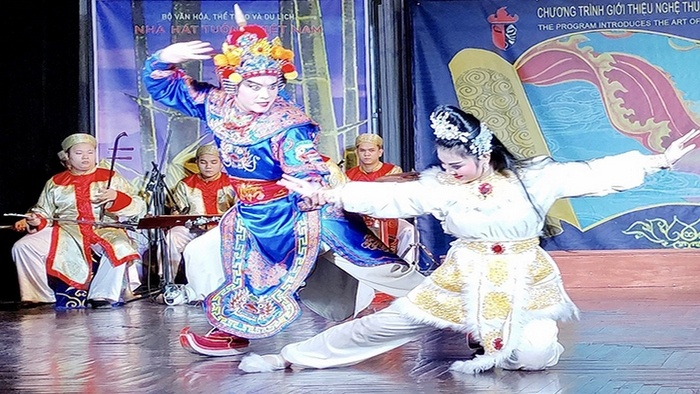Vietnam Tuong Theatre has developed a special program to introduce Tuong, a traditional art form, to young audiences in order to bring it closer to the modern public. Several unique excerpts were performed by the artists during a presentation to the leaders of the Ministry of Culture, Sports, and Tourism. These included plays such as “Old man carrying his young wife on his back to a festival,” “Ho Nguyet Co turning into a fox,” “Tran Quoc Toan goes to the front,” and “On Dinh beheaded Ta.” These plays have been thoroughly prepared for introduction at schools with the aim of inspiring a love for Tuong among younger generations.
The program not only includes performances but also various activities to introduce the traditional art form through quotes and comments, including an exchange between the artists and the audience. Viewers are invited to the stage to familiarize themselves with the instruments and perform movements with the artists. They can also ask questions to learn more about the special features and basic principles of Tuong in performing, dancing, makeup, and music.
Ta Van Sop, Deputy Director of Vietnam Tuong Theatre, who developed the program, highlighted that traditional art units have previously focused on performances or short-term training courses, lacking specialization and sustainability. Recognizing the importance of sparking interest and aspiration for learning about Tuong among younger audiences, the theatre decided to develop a program that is close and independent. The program’s implementation is flexible and tailored to the time, space, and requirements of each training institution, with a focus on interactive activities that are equivalent in time to the performances.
Tuong has a strength in exploring historical topics, making it suitable for schools. Students can absorb historical knowledge naturally and enthusiastically through Tuong excerpts. This creates an opportunity for them to raise questions and deepen their understanding of Tuong, such as the symbolism behind different colors and textures on the characters’ faces and the significance of artists turning around before performing.
The program was developed over the course of 2019 to late 2020, with a focus on conveying information in an intimate, understandable, and attractive manner to audiences of different educational levels. The theatre reviewed the entire historical and literary program from grade 1 to 12 to find historical characters and issues that can be reflected through Tuong. They also identified plays suitable for students at different grade levels, with the most unique plays being introduced to universities and colleges.
The artists have dedicated their efforts to practicing and rehearsing the performances, with four different crews ensuring the continuity of the program and the ability to perform in multiple venues simultaneously. Young artists were prioritized for their promising talent and ability to connect with younger audiences. The theatre will create a special fan page for the program to enhance the interaction and connection between audiences and the Tuong art form online.
The program’s organizers hope for collaboration between the cultural and educational sectors to facilitate Tuong’s reach to young people in training institutions. By systematically forming future audiences, the preservation and promotion of the values of Tuong and traditional stage arts can be effectively and sustainably achieved.




